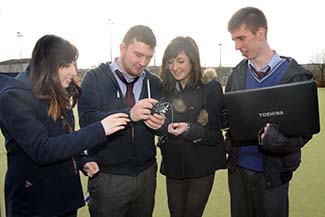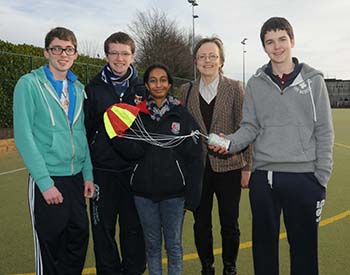Cork School will represent Ireland at the European CanSat final in Portugal in June 2015.

Published on: Friday, 17 April 2015
News Update 17th April 2015
A team of students from Scoil Mhuire Gan Smál in Blarney, Co Cork have won the 2015 Esero Ireland – CEIA National CanSat competition and will represent Ireland at the European CanSat final in Portugal in June 2015.
Newslinks:
- Cork school aiming for the stars after winning big with micro-satellite - http://www.siliconrepublic.com/innovation/item/41655-cork-school-aiming-for-the/
- Cork school shoots for the stars at CanSat competition - http://www.techcentral.ie/cork-school-shots-for-the-stars-in-cansat-competition/
- Cork school to represent Ireland at European Space Agency competition in Portugal - http://irishtechnews.net/ITN3/cork-school-to-represent-ireland-at-european-space-agency-competition-in-portugal/
- Cork school team wins national CanSat competition - http://www.businessandleadership.com/leadership/item/50323-cork-school-team-wins/
........................................................................................................................................................
Second-level students from Douglas Community School, Cork and Scoil Mhuire Gan Smál, Blarney qualify for the National Final of the Irish CanSat competition 2015.
28 February 2015 – Douglas Community School, Cork and Scoil Mhuire Gan Smal, Blarney were announced as the winning teams at the Munster final of the 2015 CanSat competition at CIT. The competition was sponsored by Moog, Horner APG, Genesis Circuits, SFI Discover, and ESA. The winning teams will now go on to compete at the National final of the competition at Birr Castle, Co. Offaly on 18th April. Following that, the national winners will represent Ireland at the European CanSat final in Portugal in June of this year.
This year 7 Munster schools took part in this unique space project to create a CanSat – a simulation of a real satellite which fits into the volume of a soft drinks can. The teams have been working tirelessly since October with mentors from CIT, UCC and industry to bring their CanSat from design stage to lift off. Having selected the mission and integrated the components, the teams launched their CanSats using a quadcopter, which after release, returned to Earth safely using a parachute. As it ascended and descended, the CanSat captured data from sensors about its environment, and transmitted it wirelessly to the ground-station. The CanSat teams then analysed this data and made a presentation to a panel of judges.
Munster students have already achieved notable success in the European CanSat competition, run by the European Space Agency (ESA). In the last two years, the winners of the Irish National CanSat competition were from Colaiste an Phiarsaigh in Glanmire and Crescent College Comprehensive, Limerick, coming second and third place at the European CanSat finals in the Netherlands (2013), and Norway (2014), where their CanSats were launched by rocket to an altitude of 1km.
The schools that took part in the Munster final were:
| Douglas Community School, Cork Scoil Mhuire Gan Smal, Blarney Presentation Brothers College, Cork Christian Brothers School, Cork |
Glanmire Community College Christ King Girls School, Cork Ashton School – CAN/ASH CanSat Team |
 |
 |
Second-level students from Scoil Mhuire Gan Smál, Blarney and Douglas Community School, Cork qualify for the National Final of the Irish CanSat competition 2015.
..............................................................................................................................................................................................................................................
NEWS - November 2014
Former NASA Astronaut Helps Launch Unique Space Competition
Mentoring support to be provided by Cork Institute of Technology and industry partners Moog & Horner APG
Cork CanSat 2015 Teams
| Christian Brother College – Sidney Hill, Cork City Scoil Mhuire gan Smal, Blarney Co Cork Midelton College, Midelton, Co Cork Douglas Community College , Clermont Avenue , Douglas, Co Cork Regina Mundi, Douglas , Co Cork |
St Aloysius, Sharman Crawford St, Cork Christ the King , Half Moon Lane, South Douglas Rd, Cork City Presentation Brothers College, Mardyke, Co Cork Community College Cobh , Co Cork Glanmire Community College, Brooklodge, Glanmire |
The 2015 ESERO Ireland - CEIA CanSat Competition was launched in November 2014 with the help of former NASA astronaut and President and Executive Director for the Centre for the Advancement of Science in Space (CASIS) Greg Johnson. The competition offers second level school students a unique opportunity to participate in a real space project by building a CanSat – a simulation of a satellite which fits into the volume of a soft drinks can.
CanSat is a joint collaboration between ESERO Ireland (European Space Education Resource Office) and Cork Electronics Industry Association (CEIA.ie), and is co-funded by the European Space Agency (ESA) and Science Foundation Ireland Discover Programme.
All of the participating teams, including ten Cork teams, will launch their CanSats at regional finals across Ireland in 2015, with the winner of the national competition going on to compete in the European final in Portugal, June 2015. The Cork teams will be supported by mentors from CIT and industry partners Moog & Horner APG.
Irish students have achieved notable success in previous CanSat competitions, run by the European Space Agency. In 2014, the winners of the national CanSat competition, a team from Crescent College Comprehensive in Limerick succeeded in securing third place at the European CanSat finals in Norway, where their CanSat was launched by rocket to an altitude of 1km. In 2012, a team of nine students from Colaiste an Phiarsaigh in Cork won second place at the competition in the Netherlands.
Commenting on the competition, Minister for Skills, Research and Innovation Damien English, said: “A key component of the Government's Action Plan for Jobs is the role of science, technology, engineering and maths (STEM) in creating high quality jobs and consolidating Ireland’s position as a true knowledge economy. It is crucial that we continue to build a pipeline of students opting for STEM related courses at third level and initiatives such as CanSat are integral in this regard. We are seeing positive results with over 70,000 or 28% of students enrolled in Science and Engineering courses last year.”
Former NASA astronaut and President and Executive Director for the Centre for the Advancement of Science in Space (CASIS) Greg Johnson, said: “For students, a career in the space industry can sometimes seem beyond the bounds of possibility. In Europe, there are over 30,000 employees in space manufacturing alone with a number of well-established companies based in Ireland. The CanSat competition brings space science to life for students in a meaningful, hands-on way, giving them a taste of the skills required for this thriving industry.”
Dr Ruth Freeman, Director of Strategy and Communications, Science Foundation Ireland added: “This year it was encouraging to see an increase in the number of students opting for science, technology, engineering and maths (STEM) in CAO first preferences. The CanSat competition offers secondary school students a unique opportunity to see the practical applications of STEM subjects in industry and exposure to the vast array of career opportunities open to STEM graduates. This in turn helps to ensure that the future pipeline of STEM graduates is protected.”
Dr Joe Connell, Head of Department of Electrical & Electronic Engineering, Cork Institute of Technology, said: “The CanSat competition teaches students about electronic circuits, sensors and measurements, programming, data analysis and package design all of which are core science and engineering skills. The students will work in teams where individual strengths will combine to produce a unique team solution and they will learn to communicate all aspects of this solution to their peers and to the judges. The experience will benefit the students not only in further learning but also in terms of life long skills. We are delighted to be working with the competing schools on this exciting project.”
Stephanie O’Neill, ESERO Ireland Manager, said: “ESERO Ireland’s aim, with the assistance of the European Space Agency, is to foster the skills that are required by companies operating in the space sector at an early age. Irish teams have now enjoyed two years of success at the European CanSat competition, tackling complex design, engineering and mathematical challenges as well as the softer skills of teamwork, problem solving and communicating with the support of their mentors and gaining exposure to the exciting opportunities which a career in space science can offer.”
The test for participating senior cycle second-level school students is to include all the major subsystems found in a satellite such as a computer, power, sensors and a communication system and bring their CanSat from design stage to lift off. The CanSat is launched to an altitude of a few hundred metres by a rocket and must accomplish its primary mission - to measure temperature, air pressure, transmit the data to the ground station and achieve a safe landing. Secondary missions can be devised by individual teams and in previous years included using a GPS module to track the CanSat position and measuring wind shear using a custom built anemometer. Teams work together at all stages of the process - designing the CanSat, selecting its mission, integrating the components, testing, preparing for launch, receiving the data on the ground and then analysing and presenting the data to a panel of judges.
For further information, please contact:
David Callaghan - Edelman
E: david.callaghan@edelman.com
T: 01 6789333
..............................................................................................................................
About ESERO Ireland
European Space Education Resource Office (ESERO) Ireland aims to inspire and engage young people in STEM subjects (science, technology, engineering and mathematics), using space as a theme and making Ireland’s space industry more accessible to students and the public. ESERO Ireland is co-funded by the European Space Agency (ESA) and Discover Science & Engineering (DSE). www.esero.ie
About SFI Discover
Science Foundation Ireland’s (SFI) Discover Programme seeks to support and develop the education and outreach STEM sector in Ireland by investing in developing and extending capacity in this area and also exploring and encouraging novel means of public engagement and communications. It aims to increase interest in science, technology, engineering and mathematics (STEM) among students, teachers and the public.
ESERO Ireland CEIA 2014 Munster Regional CanSat Competition at CIT - February 2014
image credit: Provision
|
Douglas Community School - Joint Winners - Artur Chalyj, Daniel Barrett, James Hodkinson, Conor Fahy, Gavin McCarthy, Cian Adams and Daniel Hurley. |
Eamon Connolly, Schools Liaison Officer CEIA, front right, with the school mentors and teachers. |
|
|
 Scoil Mhuire Gan Smal Blarney team - Aoife Healy, Kyle O'Callaghan, Lisa Higgins and Eoghan Casey. |

Some of the teams watching their CanSat take flight.

Teams working hard developing their Cansat at CIT Department of Electrical & Electronic Engineering lab.











